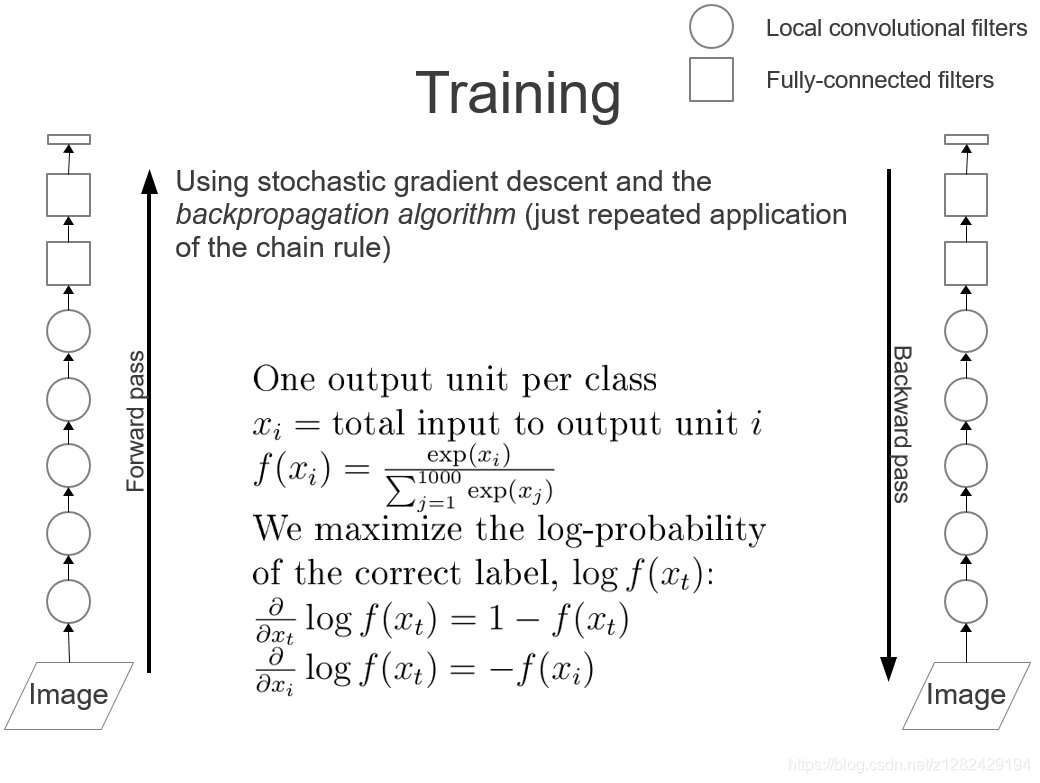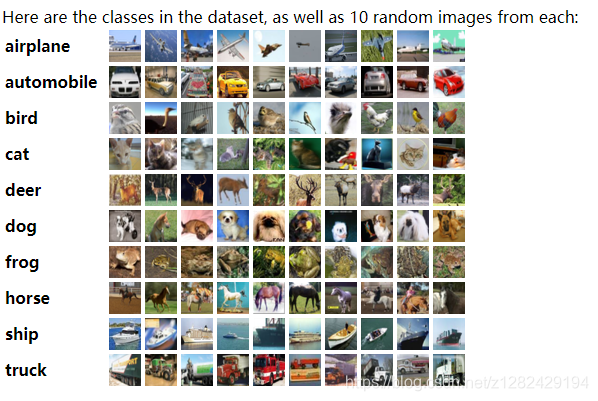《ImageNet Classification with Deep Convolutional Neural Networks》的学习和复现
(ImageNet Classification with Deep Convolutional Neural Networks,NIPS2012)
文章摘要
本文通过训练一个大规模的深度卷积神经网络用于解决图片分类问题。该神经网络有6千万个参数和6.5百万神经元,包括5个卷积层和3个全连接层。在训练过程中为了提升训练速度使用了GPU来进行模型训练,而且首次提出了“dropout”的方法,并证明了其有效性。最终该模型在ILSVRC—2012竞赛中取得图像分类错误率比第二名低10.9%的成绩获得第一名。
算法模型

此图为AexNet模型的整体框架。

此图为AlexNet模型训练时的一个示意图。
AlexNet模型参数
输入:
224
×
224
×
3
224 \times 224 \times 3
224×224×3的图片
输出:类别
- 第一层卷积层:96个 11 × 11 × 3 11\times 11\times 3 11×11×3、步长为4的卷积核;
- 第二层卷积层:256个 5 × 5 × 48 5\times 5\times 48 5×5×48的卷积核;
- 第三层卷积层:384个 3 × 3 × 256 3\times 3\times 256 3×3×256的卷积核;
- 第四层卷积层:384个 3 × 3 × 192 3\times 3\times 192 3×3×192的卷积核;
- 第五层卷积层:256个 3 × 3 × 192 3\times 3\times 192 3×3×192的卷积核;
- 三个全连接层:每一个都是有4096个神经元。
其中,第一层卷积结束、第二层卷积结束以及第五层卷积结束各有一次“Max-pooling”(最大池化)。
AlexNet的创新、不足和意义
创新
- 与相对较小的LeNet相比,AlexNet包含8层变换,其中有5层卷积和2层全连接隐藏层,以及1个全连接输出层;
- AlexNet将sigmoid激活函数改成了更加简单的ReLU激活函数;
- 通过“dropout”来控制全连接层的模型复杂度;
- 通过“Data Augumentation”,从而进一步扩大数据集来缓解过拟合;
- 采用GPU并行训练,LRN归一化层的使用。
不足
- 在性能和体积上都不占优势,在实际生产环境中也很少使用;
- 很多参数的选择都是经验得来,并无太多理论支持。
意义
- AlexNet跟LeNet结构类似,但使用了更多的卷积层和更大的参数空间来拟合大规模数据集ImageNet。它是浅层神经网络和深度神经网络的分界线;
- 虽然看上去AlexNet的实现比LeNet的实现也就多了几行代码而已,但这个观念上的转变和真正优秀实验结果的产生令学术界付出了很多年。
- AlexNet中很多参数的选择也都是经验得来,并无太多理论支持,但是往往一个参数的不同就会导致结果大相径庭。比如网络结构中卷积核的大小,或者训练时学习率,这也体现了深度神经网络调参的重要性。
- “Dropout”:保持网络的稀疏性,以避免过拟合、提高模型的泛华能力。(相关参考)
- “Data Augumentation”:随机改变训练样本可以降低模型对某些属性的依赖,从而提高模型的泛化能力。
复现
数据集
CIFAR-10 数据集:是由 Hinton 的两个大弟子 Alex Krizhevsky、Ilya Sutskever 收集的一个用于普适物体识别的数据集,其中包括10类
32
×
32
32 \times 32
32×32的彩色图片一共6万张,50000张训练,10000张测试(交叉验证)。(CIFAR-10数据集下载)

此图展示的就是CIFAR-10 数据集。
AlexNet代码
// Pytorch 代码实现
## model.py
fimport torch.nn as nn
import torch.utils.model_zoo as model_zoo
from IPython import embed
from collections import OrderedDict
from utee import misc
print = misc.logger.info
model_urls = {
'cifar10': 'http://ml.cs.tsinghua.edu.cn/~chenxi/pytorch-models/cifar10-d875770b.pth',
}
class CIFAR(nn.Module):
def __init__(self, features, n_channel, num_classes):
super(CIFAR, self).__init__()
assert isinstance(features, nn.Sequential), type(features)
self.features = features
self.classifier = nn.Sequential(
nn.Linear(n_channel, num_classes)
)
print(self.features)
print(self.classifier)
def forward(self, x):
x = self.features(x)
x = x.view(x.size(0), -1)
x = self.classifier(x)
return x
def make_layers(cfg, batch_norm=False):
layers = []
in_channels = 3
for i, v in enumerate(cfg):
if v == 'M':
layers += [nn.MaxPool2d(kernel_size=2, stride=2)]
else:
padding = v[1] if isinstance(v, tuple) else 1
out_channels = v[0] if isinstance(v, tuple) else v
conv2d = nn.Conv2d(in_channels, out_channels, kernel_size=3, padding=padding)
if batch_norm:
layers += [conv2d, nn.BatchNorm2d(out_channels, affine=False), nn.ReLU()]
else:
layers += [conv2d, nn.ReLU()]
in_channels = out_channels
return nn.Sequential(*layers)
def cifar10(n_channel, pretrained=None):
cfg = [n_channel, n_channel, 'M', 2*n_channel, 2*n_channel, 'M', 4*n_channel, 4*n_channel, 'M', (8*n_channel, 0), 'M']
layers = make_layers(cfg, batch_norm=True)
model = CIFAR(layers, n_channel=8*n_channel, num_classes=10)
if pretrained is not None:
m = model_zoo.load_url(model_urls['cifar10'])
state_dict = m.state_dict() if isinstance(m, nn.Module) else m
assert isinstance(state_dict, (dict, OrderedDict)), type(state_dict)
model.load_state_dict(state_dict)
return model
if __name__ == '__main__':
model = cifar10(128, pretrained='log/cifar10/best-135.pth')
embed()
Pytorch完整代码:Pytorch
Tensorflow完整代码:Tensorflow
PaddlePaddle代码: PaddlePaddle.
Keras代码:keras
测试结果
模型还在训练,稍后给出。
参考文献
[1] https://zh.d2l.ai
[2] https://www.cs.toronto.edu/~kriz/cifar.html
[3] https://blog.youkuaiyun.com/zeuseign/article/details/72773342
[4] https://www.cnblogs.com/vipyoumay/p/7686230.html
[5] https://zhuanlan.zhihu.com/p/27381582





 本文深入介绍了AlexNet模型,包括其架构、参数配置、创新之处及不足,并详细展示了如何使用PyTorch实现AlexNet模型并在CIFAR-10数据集上进行训练。
本文深入介绍了AlexNet模型,包括其架构、参数配置、创新之处及不足,并详细展示了如何使用PyTorch实现AlexNet模型并在CIFAR-10数据集上进行训练。
















 375
375

 被折叠的 条评论
为什么被折叠?
被折叠的 条评论
为什么被折叠?








